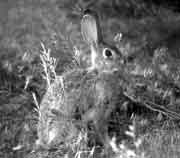NATURE HAPPENINGS - February 2001
by Damian Fagan
Tracks, Tracks, Tracks
The investigator interprets the evidence left at the scene of
the crime. "Looks like the little fellow bought it trying to
cross traffic,” the sleuth declares. Against the fresh February
snow the tracks end like a punctuation mark, except the next sentence
never begins.
 The
investigator rises from his knees and declares, “It looks like
a fly-by.”
The
investigator rises from his knees and declares, “It looks like
a fly-by.”
“Don’t you mean drive by?” someone from the crowd
asks. “When was the last time you saw an owl drive?” the
investigator retorts.
The set of rodent tracks terminated in a puff of snow. Where the
owl’s wing tips flicked against the snow, there remained the
outline of primary feathers. Case closed.
Such is the nature of the naturalist. Like the motorist who reads
signs on their journey, so too does the naturalist. Except their
“words” are bits of dried scat, fresh tracks in the snow,
fur attached to spiny plant, a deep excavation in a prairie dog
town.
Most of the mammalian wildlife observed in Canyon Country is interpreted
through tracks, scat or other signs. Due to their nocturnal preference,
many creatures avoid human observation. But just as bird watchers
identify birds solely by their calls, so too can the investigator
identify species of wildlife through signs of their passage.
For instance, take the porcupine. How many of us see these common
creatures daily? Yet there are their signs - a bowel-legged waddle
where the tracks are separated by the ground-clearing drag of their
spiny tail. Or perhaps something closer to home - the hand-sized
imprint of a BIG kitty with rounded toes and double lobes on the
top portion of the plantar pad, where the track’s edges are
still crumbling inwards.
 The
number 7-shaped track of a desert cottontail - hind feet in front
- is a classic, common track in these parts. Measure the distance
between the sets of tracks and another portion of the story unfolds.
Greater distance equals greater speed which may equal pursuit. Where
the rabbit goes is just as important as how it went, a scampering
rabbit is like trying to catch Barry Sanders in the secondary. Forget
it.
The
number 7-shaped track of a desert cottontail - hind feet in front
- is a classic, common track in these parts. Measure the distance
between the sets of tracks and another portion of the story unfolds.
Greater distance equals greater speed which may equal pursuit. Where
the rabbit goes is just as important as how it went, a scampering
rabbit is like trying to catch Barry Sanders in the secondary. Forget
it.
To compliment the track-defying identity of some wildlife species,
their scats can prove most interesting as well. The poet Alison
Hawthorne Deming described a bunch of naturalists as people who
were attracted to animal scat, not repelled by it. For instance,
this past autumn black bears were residing within, and just outside,
the Moab City limits. Many of their scats were laced with Russian
olive seeds, hard indigestible seeds bigger than rice grains; however,
some of their tracks were loaded with fish scales, presumably belonging
to some slow carp. And when the berries became ripe, the scats took
on a pinkish or purplish hue.
So the next time your out wandering in the canyons, take a moment
to note the passage of the other members of the Animalia’s
Kingdom. Though you may never see that wild cougar or seed-eating
bear, you can confirm their presence by what they left behind.
© 2001 Moab Happenings. All rights
reserved. Reproduction of information contained in this site is
expressly prohibited.